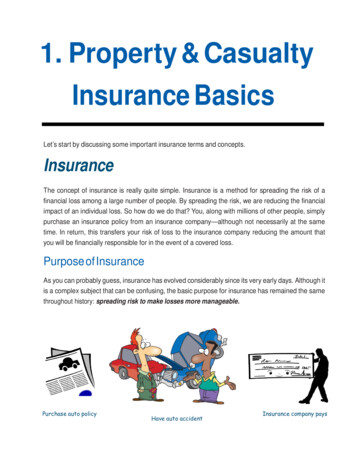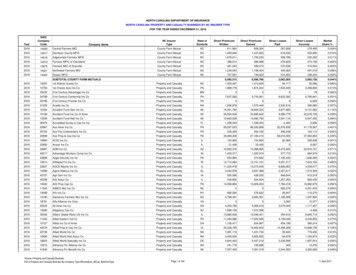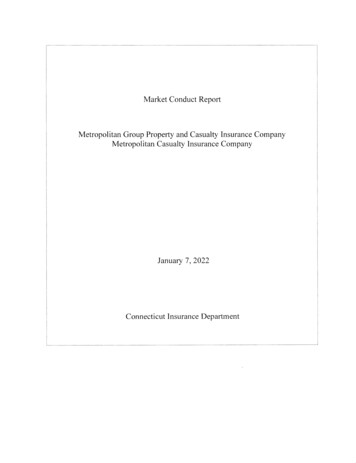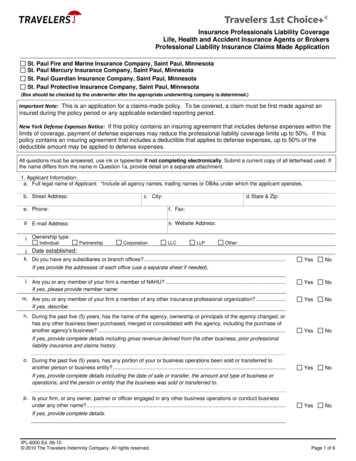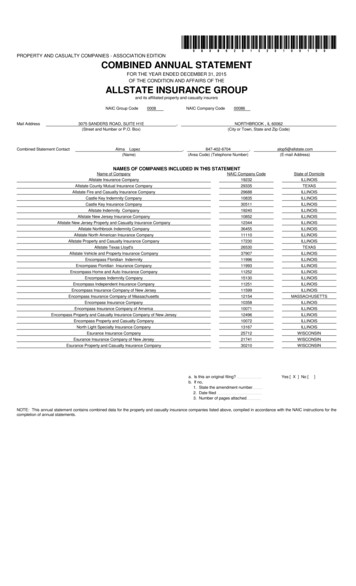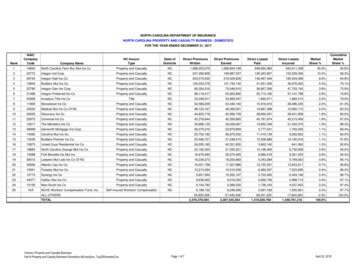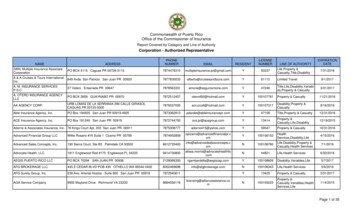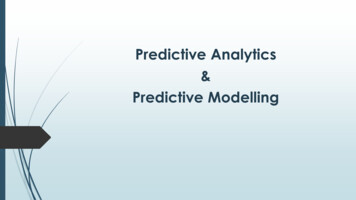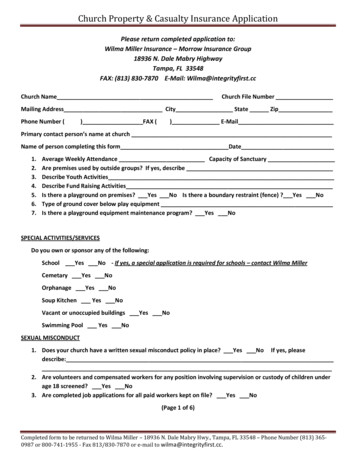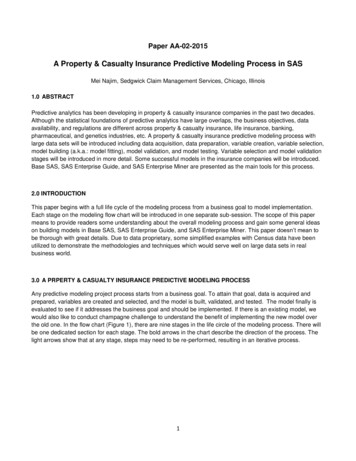
Transcription
Paper AA-02-2015A Property & Casualty Insurance Predictive Modeling Process in SASMei Najim, Sedgwick Claim Management Services, Chicago, Illinois1.0 ABSTRACTPredictive analytics has been developing in property & casualty insurance companies in the past two decades.Although the statistical foundations of predictive analytics have large overlaps, the business objectives, dataavailability, and regulations are different across property & casualty insurance, life insurance, banking,pharmaceutical, and genetics industries, etc. A property & casualty insurance predictive modeling process withlarge data sets will be introduced including data acquisition, data preparation, variable creation, variable selection,model building (a.k.a.: model fitting), model validation, and model testing. Variable selection and model validationstages will be introduced in more detail. Some successful models in the insurance companies will be introduced.Base SAS, SAS Enterprise Guide, and SAS Enterprise Miner are presented as the main tools for this process.2.0 INTRODUCTIONThis paper begins with a full life cycle of the modeling process from a business goal to model implementation.Each stage on the modeling flow chart will be introduced in one separate sub-session. The scope of this papermeans to provide readers some understanding about the overall modeling process and gain some general ideason building models in Base SAS, SAS Enterprise Guide, and SAS Enterprise Miner. This paper doesn’t mean tobe thorough with great details. Due to data proprietary, some simplified examples with Census data have beenutilized to demonstrate the methodologies and techniques which would serve well on large data sets in realbusiness world.3.0 A PRPERTY & CASUALTY INSURANCE PREDICTIVE MODELING PROCESSAny predictive modeling project process starts from a business goal. To attain that goal, data is acquired andprepared, variables are created and selected, and the model is built, validated, and tested. The model finally isevaluated to see if it addresses the business goal and should be implemented. If there is an existing model, wewould also like to conduct champagne challenge to understand the benefit of implementing the new model overthe old one. In the flow chart (Figure 1), there are nine stages in the life circle of the modeling process. There willbe one dedicated section for each stage. The bold arrows in the chart describe the direction of the process. Thelight arrows show that at any stage, steps may need to be re-performed, resulting in an iterative process.1
A Property & Casualty Insurance Predictive Modeling Process in SAS, continuedMWSUG 2015Figure 1. A Property & Casualty Insurance Predictive Modeling Process Flow Chart3.1BUSINESS GOALS AND MODEL DESIGNSpecific business goals/problems decide the model design - what type(s) of model(s) to build. Sometimes whenbusiness goals are not clear, we can start to look into the available data sources to find more information to helpto (re)define those goals. In the insurance companies, pricing and underwriting properly, reserving adequately,and controlling costs to handle and settle claims are some of the major business goals for predictive modelingprojects.3.2DATA SCOPE AND ACQUISITIONBased on the specific business goals and the designed model, data scope is defined and the specific dataincluding internal and external data is acquired. Most middle to large size insurance organizations havesophisticated internal data systems to capture their exposures, premiums, and/or claims data. Also, there aresome variables based on some external data sources that have been proved to be very predictive. Someexternal data sources are readily available such as insurance industry data from statistical agencies (ISO, AAIS,and NCCI), open data sources (demographics data from Census), and other data vendors.3.3DATA PREPARATION3.3.1Data Review, Cleansing, and TransformationUnderstanding every data field and its definition correctly is the foundation to make the best use of the datatowards building good models. Data review is to ensure data integrity including data accuracy, consistency, andthat basic data requirements are satisfied and common data quality issues are identified and addressed properly. If the part ofthe data isn’t reflected the trend into future, it should be excluded.For example, initial data review is to see if each field has decent data volume to be credible to use. Obvious dataissues, such as blanks and duplicates, are identified, and either removed or imputed based on reasonable2
A Property & Casualty Insurance Predictive Modeling Process in SAS, continuedMWSUG 2015assumptions and appropriate methodologies. Missing value imputation is a big topic with multiple methods so weare not going to go into detail in this paper.Here are some common SAS procedures in both Base SAS and SAS Enterprise Guide:PROC CONTENTS/PROC FREQ/PROC UNIVARIATE/PROC SUMMARYThe Data Explore Feature in SAS Enterprise Miner is also a very powerful way to quickly get a feel for how data isdistributed across multiple variables. The example below with some data fields is from Census data source.Figure 2. A Data Review Example using CENSUS node (Data Source) and StatExplore node in SAS Enterprise MinerThe diagram (Figure 3) below is the Data Explore feature from CENSUS node in the diagram (Figure 2) above. Itshows how a distribution across one variable can be drilled into to examine other variables. In this example, theshaded area of the bottom graph represents records with median household income between 60,000 and 80,000. The top two graphs show how these records are distributed across levels of two other variables.Figure 3. Data Explore Graphs from CENSUS Node (Data Source) in SAS Enterprise Miner3
A Property & Casualty Insurance Predictive Modeling Process in SAS, continuedMWSUG 2015The result report (Figure 4) with thorough statistics for each variable is provided after running StatExplore nodein the diagram (Figure 2). Please see the following diagram (Figure 4) of a result report with three data fields fromCENSUS data. When the data source contains hundreds or thousands fields, this node is a very efficient way toconduct a quick data explore.Figure 4. Results Report Using StatExplore node in SAS Enterprise MinerWhen the variables exhibit asymmetry and non-linearity, data transformation is necessary. In SAS EnterpriseMiner, Transform Variables node is a great tool to handle data transformation. The diagram below (Figure 5) isan example of data transformation procedure in SAS Enterprise Miner.Figure 5. A Data Transformation Procedure Using Transform Variables node in SAS Enterprise Miner4
A Property & Casualty Insurance Predictive Modeling Process in SAS, continued3.3.2MWSUG 2015Data Partition for Training, Validation, and TestingIf data volume allows, data could be partitioned into training, validation, and holdout testing data sets. Thetraining data set is used for preliminary model fitting. The validation data set is used to monitor and tune themodel during estimation and is also used for model assessment. The tuning process usually involves selectingamong models of different types and complexities with the goal of selecting the best model balancing betweenmodel accuracy and stability. The holdout testing data set is used to give a final honest model assessment. Inreality, different break-down percentages across training, validation, and holdout testing data could be useddepending on the data volume and the type of model to build, etc. It is not rare to only partition data into trainingand testing data sets, especially when data volume is concerned.The diagram (Figure 6) below shows a data partition example. In this example, 80% of the data is for training,10% for validation, and 10% for holdout testing.Received Raw Data as of 12/31/2014 (12,000K obs)Data Exclusion and CleansingCleansed Data in Scope (10,000K obs)80% Training10% Validation10% Holdout TestingNew Data Testing80% Training8,000K ( 80% X 10,000K)10 % Model Validation1,000K ( 10% X 10,000K)10% Holdout Testing1,000K ( 10% X 10,000K)Cross Validation(Detail in the 3.7)New Data Testing (1/1/2015-9/30/2015)Figure 6. A Data Partition Flow ChartThe diagram below (Figure 7) is the data partition example in SAS Enterprise Miner. This node uses simplerandom sampling, stratified random sampling, or cluster sampling to create partitioned data sets.Figure 7. A Data Partition Procedure Example Using Data Partition node in SAS Enterprise Miner5
A Property & Casualty Insurance Predictive Modeling Process in SAS, continued3.4VARIABLE CREATION3.4.1Target Variable Creation (a.k.a.: Dependent Variable or Responsible Variable)MWSUG 2015Every data mining project begins with a business goal which defines the target variable from a modelingperspective. The target variable summarizes the outcome we would like to predict from the perspective of thealgorithms we use to build the predictive models. The target variable could be created based on either a singlevariable or a combination of multiple variables.For example, we can create the ratio of total incurred loss to premium as the target variable for a loss ratio model.Another example involves a large loss model. If the business problem is to identify the claims with total incurredloss greater than 250,000 and claim duration more than 2 years, then we can create a target variable - “1” whenboth total incurred loss exceeding 250,000 and claim duration more than 2 years, else “0”.3.4.2Other Predictive Variables CreationMany variables can be created directly from the raw data fields they represent. Other additional variables can becreated based on the raw data fields and our understanding of the business. For example: loss month can be avariable created based on the loss date field to capture potential loss seasonality. It could be a potentiallypredictive variable to an automobile collision model since automobile collision losses are highly dependent onwhat season it is. When the claim has a prior claim, we can create a prior claim indicator which potentially couldbe predictive variable to a large loss model.Another example involves external Census data, where a median household income field could be used to createa median household income ranking variable by ZIP code which could be predictive to workers’ compensationmodel.3.4.3Text Mining (a.k.a.: Text Analytics) to create variables based on unstructured dataText Analytics uses algorithms to derive patterns and trends from unstructured (free-form text) data throughstatistical and machine learning methods (usually parsing, along with the addition of some derived linguisticfeatures and the removal of others, and subsequent insertion into a database), as well as natural languageprocessing techniques. The diagram (Figure 8) below shows a text mining process example in SAS EnterpriseMiner.Figure 8. A Text Mining Procedure Example in SAS Enterprise Miner6
A Property & Casualty Insurance Predictive Modeling Process in SAS, continued3.4.4MWSUG 2015Univariate AnalysisAfter creating target variable and other variables, univariate analysis usually has been performed. In theunivariate analysis, one-way relationships of each potential predictive variable with the target variable areexamined. Data volume and distribution are further reviewed to decide if the variable is credible and meaningful inboth a business and a statistical sense. A high-level reasonability check is conducted. In this univariate analysis,our goal is to identify and select the most significant variables based on statistical and business reasons anddetermine the appropriate methods to group (bin), cap, or transform variables.The SAS procedure PROC UNIVARIATE could be utilized in Base SAS and SAS Enterprise Guide. Some of thedata review methods and techniques in data preparation could be utilized as well.In addition to the previously introduced procedures, the diagram below (Figure 9) shows how Graph Exploreprocedure can also be used to conduct univariate analyses in SAS Enterprise Miner.Figure 9. Univariate Analyses Using Graph Explore node in SAS Enterprise Miner3.5 VARIABLE SELECTION (a.k.a.: VARIABLE REDUCTION)When there are over hundreds or even thousands of variables after including various internal and external datasources, the variable selection process becomes critical. See some common variable selection techniques below:1) Correlation Analysis: Identify variables which are correlated to each other to avoid multicollinearity to build amore stable model2) Multivariate Analyses: Cluster Analysis, Principle Component Analysis, and Factor Analysis. Cluster Analysis ispopularly used to create clusters when there are hundreds or thousands of variables.Some common SAS procedures as follows:PROC CORR/PROC VARCLUS/PROC FACTOR3) Stepwise Selection Procedure: Stepwise selection is a method that allows moves in either direction, droppingor adding variables at the various steps.7
A Property & Casualty Insurance Predictive Modeling Process in SAS, continuedMWSUG 2015Backward stepwise selection starts with all the predictors to remove the least significant variable, and thenpotentially add back variables if they later appear to be significant. The process is one of alternation betweenchoosing the least significant variable to drop and then re-considering all dropped variables (except the mostrecently dropped) for re-introduction into the model. This means that two separate significance levels must bechosen for deletion from the model and for adding to the model. The second significance must be more stringentthan the first.Forward stepwise selection is also a possibility, though not as common. In the forward approach, variablesonce entered may be dropped if they are no longer significant as other variables are added.Stepwise RegressionThis is a combination of backward elimination and forward selection. This addresses the situation wherevariables are added or removed early in the process and we want to change our mind about them later. Ateach stage a variable may be added or removed and there are several variations on exactly how this is done.The simplified SAS code below shows how a stepwise logistic regression procedure to select variables for alogistic regression model (binary target variable) can be used in Base SAS/SAS EG.proc logistic data datasample;model target fraud (event '1') var1 var2 var3/selection stepwise slentry 0.05 slstay 0.06;output out datapred1 p phat lower lcl upper ucl;run;In SAS Enterprise Miner, procedures for selecting variables use the Variable Selection Node. This procedureprovides a tool to reduce the number of input variables using R-square and Chi-square selection criteria. Theprocedure identifies input variables which are useful for predicting the target variable and ranks the importance ofthese variables. The diagram below (Figure 10) contains an example.Figure 10. A Variable Selection Example Using Variable Selection node in SAS Enterprise MinerIn SAS Enterprise Miner, procedures for selecting variables involve using the Regression Node to specify amodel selection method. If Backward is selected, training begins with all candidate effects in the model andremoves effects until the Stay significance level or the stop criterion is met. If Forward is selected, training beginswith no candidate effects in the model and adds effects until the Entry significance level or the stop criterion ismet. If Stepwise is selected, training begins as in the Forward model but may remove effects already in themodel. This continues until the Stay significance level or the stop criterion is met. If None is selected, all inputsare used to fit the model. The diagram below (Figure 11) contains an example.8
A Property & Casualty Insurance Predictive Modeling Process in SAS, continuedMWSUG 2015Figure 11. A Variable Selection Example Using Regression node in SAS Enterprise MinerIn SAS Enterprise Miner, procedures for selecting variables can use the Decision Tree Node. This procedureprovides a tool to reduce the number of input variables by specifying whether variable selection should beperformed based on importance values. If this is set to Yes, all variables that have an importance value greaterthan or equal to 0.05 will be set to Input. All other variables will be set to Rejected. The diagram below (Figure 12)contains an example.Figure 12. A Variable Selection Example Using Decision Tree Node in SAS Enterprise Miner3.6MODEL BUILDING (a.k.a.: MODEL FITTING)The Generalized Linear Modeling (GLM) technique has been popular in the property and casualty insuranceindustry for building statistical models. There are usually many iterations to fit models until the final model, whichis based on both desired statistics (relatively simple, high accuracy, high stability) and business application, isachieved. The final model includes the target variable, independent variables, and multivariate equations withweights and coefficients for the variables used.Below is a simplified SAS code of a logistic regression fit using PROC GENMOD (GLM) in Base SAS/SASEnterprise Guide:9
A Property & Casualty Insurance Predictive Modeling Process in SAS, continuedMWSUG 2015proc genmod data lib.sample;class var1 var2 var3 var4;model retention var1 var2 var3 var4 var5/dist binlink logit lrci;output out lib.sample p pred;run;The same GLM logistic regression procedure can be done using Regression node with specifying modelselection as GLM in SAS Enterprise Miner. The diagram below (Figure 13) contains an example.Figure 13. A GLM Logistic Regression Example Using Regression node in SAS Enterprise MinerInteraction and correlation usually should be examined before finalizing the models if possible.Other model building/fitting methodologies could be utilized to build models in SAS Enterprise Miner including thefollowing three types of models (The descriptions below are attributable to SAS Product Documentation):Decision Tree Model: Decision Tree is a predictive modeling approach which maps observations about an itemto conclusions about the item's target value. A decision tree divides data into groups by applying a series ofsimple rules. Each rule assigns an observation to a group based on the value of one input. One rule is appliedafter another, resulting in a hierarchy of groups. The hierarchy is called a tree, and each group is called a node.The original group contains the entire data set and is called the root node of the tree. A node with all itssuccessors forms a branch of the node that created it. The final nodes are called leaves. For each leaf, a decisionis made and applied to all observations in the leaf. The paths from root to leaf represent classification rules.Neural Network Model: Organic neural networks are composed of billions of interconnected neurons that sendand receive signals to and from one another. Artificial neural networks are a class of flexible nonlinear modelsused for supervised prediction problems. The most widely used type of neural network in data analysis is themultilayer perceptron (MLP). MLP models were originally inspired by neurophysiology and the interconnectionsbetween neurons, and they are often represented by a network diagram instead of an equation. The basicbuilding blocks of multilayer perceptrons are called hidden units. Hidden units are modeled after the neuron.Each hidden unit receives a linear combination of input variables. The coefficients are called the (synaptic)weights. An activation function transforms the linear combinations and then outputs them to another unit that canthen use them as inputs.10
A Property & Casualty Insurance Predictive Modeling Process in SAS, continuedMWSUG 2015Rule Induction Model: This model combines decision tree and neural network models to predict nominal targets.It is intended to be used when one of the nominal target levels is rare. New cases are predicted using acombination of prediction rules (from decision trees) and a prediction formula (from a neural network, by default).The following diagram (Figure 14) shows a simplified example of model building procedure with four models in theSAS Enterprise Miner.Figure 14. A Simplified Example of Model Building Procedure with Four Models3.7 MODEL VALIDATIONModel validation is a process to apply the model on the validation data set to select a best model from candidatemodels with a good balance of model accuracy and stability. Common model validation methods include LiftCharts, Confusion Matrices, Receiver Operating Characteristic (ROC), Bootstrap Sampling, and Cross Validation,etc. to compare actual values (results) versus predicted values from the model. Bootstrap Sampling and CrossValidation are especially useful when data volume is not high.Cross Validation is introduced through the example (Figure 15) is below. Four cross fold subset data sets arecreated for validating stability of parameter estimates and measuring lift. The diagram shows one of the crossfolds, but the other three would be created by taking other combinations of the cross validation data sets.Cross Validation (80% Training Data)20% RandomTraining2M ( 20% X 10M)20% RandomTraining2M ( 20% X 10M)20% RandomTraining2M ( 20% X 10M)20% RandomTraining2M ( 20% X 10M)Cross Fold 1 (60% Random Training Data)Figure 15. A Diagram of Creating Cross Four Fold Subset Data Sets for Cross Validation11
A Property & Casualty Insurance Predictive Modeling Process in SAS, continuedMWSUG 2015In SAS Enterprise Miner, run the model fitting (Logistics Regression or Decision Tree, etc.) on each of the crossfold subset data sets to get parameter estimates. Then examine the four sets of parameter estimates side by sideto see if they are stable. A macro could be created and utilized to run the same model fitting process on four crossfold subset data sets.Figure 16. A Cross Validation Example Using Decision Tree node in SAS Enterprise MinerThe following common fit statistics are reviewed for model validation:3.8Akaike's Information CriterionAverage Squared ErrorAverage Error FunctionMisclassification RateMean SquareMODEL TESTINGModel testing is performed by using the best model from the model validation process to further evaluate themodel performance and provide a final honest model assessment. Model testing methods are similar as modelvalidation but using holdout testing data and/or new data (See Figure 6).The following diagram (Figure 17) shows a predictive modeling process with major stages starting from prepareddata to data partition, variable selection, building logistic regression model, and testing (scoring) new data in SASEnterprise Miner.Figure 17. A Simplified Predictive Modeling Flow Chart in SAS Enterprise Miner12
A Property & Casualty Insurance Predictive Modeling Process in SAS, continuedMWSUG 20153.9 MODEL IMPLEMENTATIONThe last but very important stage of any predictive modeling project is the model implementation which is thestage to turn all the modeling work into action to achieve the business goal and/or solve the business problem.Usually before model implementation, a model pilot would be helpful to get some sense of the model performanceand prepare for the model implementation appropriately. If there is an existing model, we would also like toconduct a champion challenge to understand the benefit of implementing the new model over the old one. Thereare numeric ways to implement the models which largely depends on what type of models and the collaborationwith IT support at the organization.4.0 SOME SUCCESSFUL MODELSPricing Model is to predict how much premium should be charged for each individual policy. Retention Model is topredict whether the policy will stay with the insurance company or not. Fraud Model is to predict whether thepolicy will be involved in fraud or not. Large Loss Model is to predict if the loss will be exceeding a certainthreshold or not.5.0 CONCLUSIONWhile we are aware that there are always multiple ways to build models to accomplish the same business goals,the primary goal of this paper is to introduce a common P&C insurance predictive modeling process in SASEnterprise Guide and Enterprise Miner. P&C insurance predictive analytics, just like any other industry, has beenfurther developing and evolving along with new technology, new data sources, and new business problems.There will be more advanced predictive analytics to solve more business problems using SAS products in thefuture.6.0 TRADEMARK CITATIONSSAS and all other SAS Institute Inc. product or service names are registered trademarks or trademarks of SASInstitute Inc. in the USA and other countries. indicates USA registration. Other brand and product names aretrademarks of their respective companies.7.0 REFERENCES:Census Data Source (http://www.census.gov/)SAS Product Documentation (http://support.sas.com/documentation/)13
A Property & Casualty Insurance Predictive Modeling Process in SAS, continued8.0 CONTACT INFORMATIONYour comments and questions are valued and encouraged. Contact the author at:Name: Mei NajimCompany: Sedgwick Claim Management ServicesE-mail: mei.najim@sedgwick.com/yumei100@gmail.com14MWSUG 2015
A Property & Casualty Insurance Predictive Modeling Process in SAS, continued MWSUG 2015 3 assumptions and appropriate methodologies. Missing value imputation is a big topic with multiple methods so we are not going to go into detail in this paper. Here are some common SAS procedures in both Base
